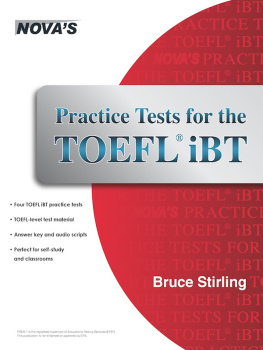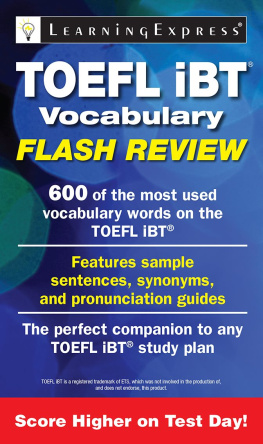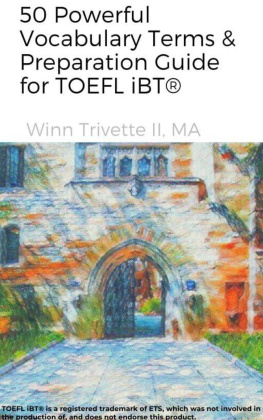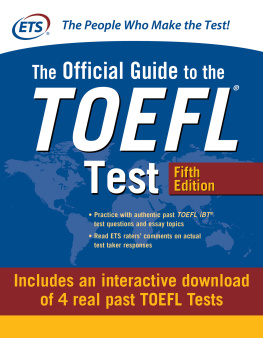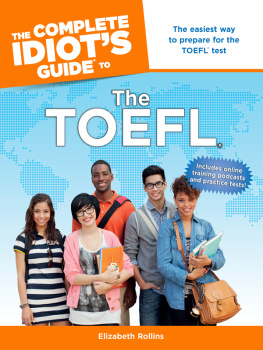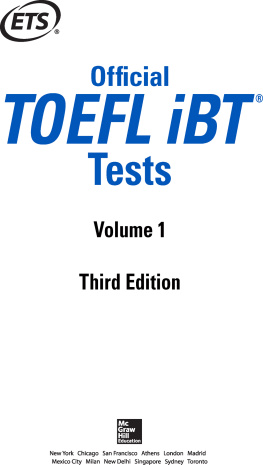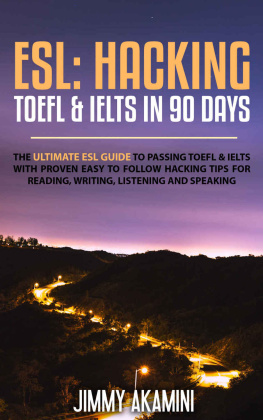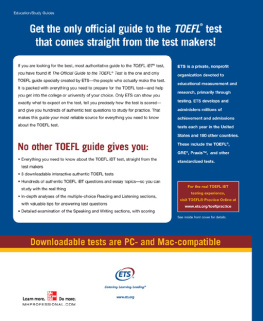

Copyright 2012 by Bruce Stirling. All rights reserved. First Edition
Test samples by Bruce Stirling.
Graphics and layout design by Bruce Stirling.
Audio written and produced by Bruce Stirling.
Sound engineer Jon Conine.
Editors
Patricia Stirling, Gretchen Anderson, Kateryna Kucher, Renata C. T. Rabacov, Yosra Ben Chikh Brahim, Oussama Bellaleh.
Audio Talent
Patricia Stirling, Gretchen Anderson, Jennie Farnell, Bruce Stirling.
Duplication, distribution or database storage of any part of this work by any means is prohibited without prior written approval of the publisher.
For permission to use material from this text in any form, please forward your request to .
ISBN-10: 1889057940
ISBN-13: 9781889057941
Published by Nova Press
9058 Lloyd Place
West Hollywood, CA USA 90069
1-800-949-6175
www.novapress.net
Contents
Also by Bruce Stirling
Scoring Strategies for the TOEFL iBT
- A Complete Guide -
Nova Press, Los Angeles, USA
Speaking and Writing Strategies for the TOEFL iBT
Nova Press, Los Angeles, USA
Speaking and Writing Strategies for the TOEFL iBT
Chinese version published by Foreign Language Teaching and Research Press Beijing, China
Speaking and Writing Strategies for the TOEFL iBT
published by Prakash Books, New Delhi, India available at uRead.com
500 Words, Phrases and Idioms for the TOEFL iBT plus Typing Strategies
Nova Press, Los Angeles, USA
Got a TOEFL question? Ask Bruce Stirling
Visit Bruce Stirling TOEFL Pro on facebook and www.toeflpro.blogspot.com
To the Test-Taker
This book contains four, full-length TOEFL iBT practice tests.
Each practice test
reflects the design of the official TOEFL iBT;
tests English-language proficiency expected of first and second year college and university students in the United States, Canada, Australia, New Zealand, Ireland, Scotland and England;
provides extra practice before you take the official TOEFL iBT;
will help you identify those areas of English you need to improve for a higher TOEFL iBT score;
will give you an unofficial, TOEFL iBT range score within a 10-point range;
will help you determine: 1) if you need to take a TOEFL iBT preparation class and/or ESL classes to increase your proficiency of academic English required at the TOEFL level, or; 2) if you are ready to take the TOEFL iBT.
When doing each practice test
Do not use a dictionary or a grammar checker.
You may take notes. On test day, you must use test-center paper and pencils.
Watch the clock. Be consistent and accurate when timing yourself.
Take a 10-minute break between the listening section and the speaking section. On test day, you will get a 10-minute break between these two sections.
Do not stop and start when taking a test. Complete each test in one sitting. This will help make you test-ready.
Your official speaking and writing responses will be scored by two or more raters. The average of their scores will be your final speaking score and writing score. When practicing for the TOEFL iBT, it is not always possible to get two or more qualified raters to rate, then average, your practice speaking and writing responses. However, you can still rate like an official rater. The raters are trained to identify specific rhetorical elements in your spoken and written responses. Those rhetorical elements are defined in the speaking proficiency checklists (pg. 221 + 224) and the essay proficiency checklists (pg. 231 + 234). These user-friendly checklists and rating guides were designed by the author.
Type your essays. On test day, you will type two essays using a regular Microsoft keyboard. A regular Microsoft keyboard is not touch sensitive like a laptop keyboard.
When typing your essays, you can cut, paste and copy, and keep track of the word count. Do not use a spell checker or a grammar checker.
On test day, you will do the TOEFL iBT test on a computer in a secure test center. The computer version of the TOEFL iBT is user-friendly. While these paper practice tests are excellent preparation, do sample computer-based tests as well. For sample TOEFL iBT computer tests, visit www.ets.org/toefl.
TOEFL iBT Facts
What is the TOEFL iBT?
The TOEFL iBT is an English-language proficiency test. TOEFL means test of English as a foreign language. iBT means internet-based test.
What is Educational Testing Service (ETS)?
Educational Testing Service designs and implements the TOEFL iBT worldwide. ETS is located in Princeton, New Jersey, USA. When you take the TOEFL iBT, you will use a desktop computer connected to the internet. Your responses will be sent via the internet to ETS to be scored. For more information, visit www.ets.org/toefl.
Why TOEFL?
Many non native English speakers wish to study or practice professionally in English-speaking countries, such as the United States and Canada. To do so, they are required to demonstrate English-language proficiency. Enter TOEFL.
What does the TOEFL iBT test?
The TOEFL iBT tests:
1) your ability to apply academic English across four skill sets: reading, listening, speaking, writing;
2) your ability to learn new material at the academic level, then answer questions about that material in a timed environment.
What are the topics?
The topics used for testing are those found in first and second year university life science and humanities courses, such as biology, economics, art, geology, zoology, literature, and history. The TOEFL iBT does not test applied sciences, such as physics and mathematics, nor does it test current events.
Remember! You do not need to study life sciences and the humanities before you take the TOEFL iBT. The TOEFL iBT will teach you all you need to know to answer questions specific to the task. In this way, the TOEFL iBT is a learning test.
Can I fail the TOEFL iBT?
No. You cannot pass or fail the TOEFL iBT. The TOEFL iBT measures your ability to understand and apply academic English on a scale from 0 to 120. The higher your score, the higher your English-language proficiency.
Task Order
The TOEFL iBT is divided into four test sections. You cannot change the task order. You must type your two essays. You may take notes throughout.

What TOEFL iBT score do I need?
Undergraduate applicants in the U.S. and Canada should aim for at least 80/120. Graduate school applicants should aim for at least 90/120.
Remember! The TOEFL score you need is different from the score you want. All test-takers want a perfect TOEFL score. However, if you only need 85 to enter the college of your choosing, then 85 is a good score.
The TOEFL requirements for each school are different. Before you take the TOEFL iBT, contact the school of your choosing and find out their TOEFL requirements. Professional license applicants should consult their licensing agencies for TOEFL requirements.
The TOEFL PBT and CBT
The TOEFL PBT (paper-based test) is the original TOEFL test. It was replaced by the CBT (computer-based test), which was replaced by the iBT (internet-based test). The CBT has been discontinued. The PBT is still offered at select locations. Visit www.ets.org/toefl for PBT test locations. See the chart below for score comparisons.
Next page
